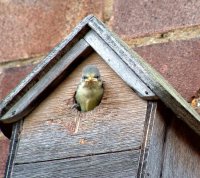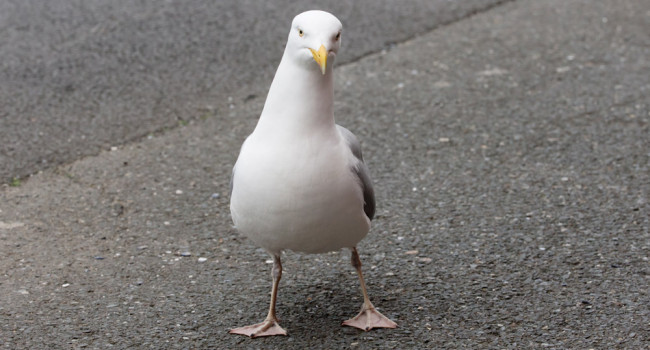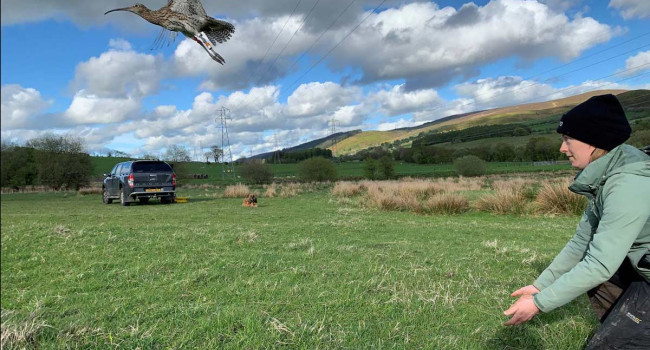Citizen science boxers fight climate change
01 Feb 2015 | No. 2015-06
It may still seem like the depths of winter, but many of our birds are already gearing up for the breeding season. Dunnock, Song Thrush and Great Tit are now singing strongly during breaks in the freezing weather and the British Trust for Ornithology (BTO) are starting to receive the first records of nesting birds, with Mallard, Moorhen and Mistle Thrush already known to have fledged chicks.
Thanks to the amazing efforts of BTO volunteers, who have been monitoring nests for over 75 years, we know that the breeding season in the UK is advancing, with many species of birds laying their eggs up to 30 days earlier than they did in the mid-1960s. The 18th National Nest Box Week (NNBW), which runs from 14-21 February, encourages people to put up nest boxes, providing the ideal opportunity to contribute to this long-running national study.
Dr Dave Leech, a Senior Research Ecologist at the BTO, picks up the story. “We know that increasing spring temperatures are driving this trend, but what are the repercussions? Are earlier breeding birds able to keep pace with their insect prey, the appearance of which is also advanced by the warming climate? Or do they still miss the boat, leading to starvation of the chicks?”
“In order to answer these questions, we urgently need people to monitor nests of common birds, particularly in gardens where data on breeding attempts are surprisingly scarce. As well as providing a suitable site in a world where suitable cavities are becoming scarce, nest boxes provide an ideal opportunity to record the progress of the eggs and young. So, while putting up a box may have some local benefit, collecting data on what's inside for BTO helps bird populations far beyond the boundaries of your own garden, and National Nest Box Week is the ideal time to get involved.”
Hazel Evans, who runs the BTO’s Nest Box Challenge, an on-line survey where members of the public can submit data about nesting attempts, commented, “Preliminary results from 2014 suggest that, after two poor breeding seasons, Blue and Great Tits had a better year and the winter hasn’t been too harsh so we’re hoping for a good uptake of boxes this spring. If you put one up during National Nest Box Week, you can use Next Box Challenge to record whether it is occupied, how many eggs the birds lay and how many chicks they rear. The project originally focused on boxes, but you can now record all nests, so look out for Blackbirds, Collared Doves and Woodpigeons too.”
To find out more about nest boxes and how you can record what happens in your nest box visit http://www.bto.org/volunteer-surveys/nbc
Here are Hazel’s five top tips for putting up a nest box.
- Wherever possible try and put the box up with the entrance hole facing north, or north-east. This will ensure that the nest box is not in full sunlight for most of the day, helping to keep incubating parents and growing chicks cool.
- Think about the location carefully, close to the top of a wall where cats might be able to access the box should be avoided, and do not put one too close to a feeding station, visiting birds could well put off a prospecting pair.
- The height from the ground for a nest box varies with species. House Sparrows seem to prefer a higher nest box, close to the eaves if fitting on a building, similarly Starlings, although these will use next boxes located on trees too. For Blue and Great Tits, head height is high enough as long as tip 2 is followed. Open-fronted boxes, preferred by Robins can be located low to the ground in cover but locate higher if the garden is visited by cats.
- If making your own box use wood in excess of 15mm in thickness – this will ensure the box doesn’t warp and change shape and also provide insulation when it is cool and helps to keep the box cooler when it is warm. Different species need a different size entrance hole.
Starling – 45mm
House Sparrow – 32mm
Great Tit – 28mm
Blue Tit – 25mm
Robin – open-fronted
- Consider fitting an easily removeable lid, or one that you can open to view your nest box. This will make it easier to record what is happening in your nest box, should you want to, and make it easier to clean out at the end of the season.
Notes for Editors
- NNBW would not be possible without the support from Jacobi Jayne & Co., Britain’s nest box specialists, who created the idea together with the late Chris Mead of the BTO.
- The BTO is the UK's leading bird research charity. A growing membership and up to 60,000 volunteer birdwatchers contribute to the BTO's surveys, collecting information that underpins conservation action in the UK. The BTO maintains a staff of 100 at its offices in Thetford, Stirling, Bangor (Wales) and Bangor (Northern Ireland), who analyse and publicise the results of surveys and projects. The BTO's work is funded by BTO supporters, government, trusts, industry and conservation organisations.www.bto.org
- Nest Box Challenge gives the opportunity to help the BTO learn more about nesting birds in the UK. Anyone can take part, all they need to do is register their nest box(es)/nest(s) in their gardens or local area and record what's inside at regular intervals during the breeding season. For more information, please visit http://www.bto.org/volunteer-surveys/nbc
Contact Details
For information on recording what's in a box:
Dr Dave Leech
(BTO Senior Ecologist)
Office: 01842 750050
(9am to 5.30pm)
Email: dave.leech [at] bto.org
For information on nest boxes:
Hazel Evans
(BTO Nest Box Challenge Organiser)
Office: 01842 750050
(9am to 5.30pm)
Email: hazel.evans [at] bto.org
Images are available for use alongside this News Release.
Please contact images [at] bto.org quoting reference 2015-06
The BTO has an ISDN line available for radio interviews.
Please contact us to book an interview
Office: 01842 750050







Share this page